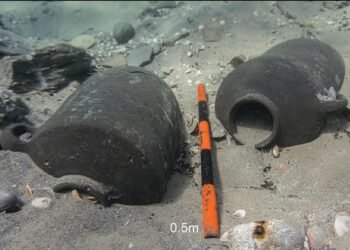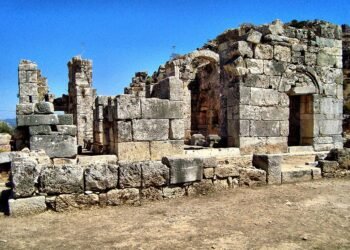A 2000-year-old battlefield in the Graubünden region of Switzerland has been unearthed, exposing the clash between the Roman Empire and local Suanetes warriors around 15 BCE.

Spearheading this archaeological revelation was volunteer archaeologist and dental student Lucas Schmid, whose initial find of a silver and brass dagger triggered an extensive excavation led by a team of scientists, students, and volunteer detectorists.
The site, located near the Crap-Ses gorge between the towns of Tiefencastel and Cunter, has been mapped by researchers from the Archaeological Service of Graubünden, the University of Basel, and the University of Zurich. Over the past two years, the team has uncovered a trove of ancient military artifacts, including spearheads, lead slingshots, brooches, shield fragments, coins, and around 2,500 hobnails left behind by Roman soldiers.
This remarkable discovery marks the first-ever Roman battle site identified in Switzerland, challenging the previously held belief that the region only bore witness to Roman settlements and not battlefield remnants. The researchers posit that a 2,000-strong force from the third, tenth, and twelfth Roman legions clashed with 500-1,000 local Suanetes fighters at the hilltop.
Historical Context
The Romans initiated their conquest of present-day southern Ticino in Switzerland’s Italian-speaking region in the third century BCE. Subsequently, they extended their dominion over the Rhone Valley, including Geneva, southern France, and the vital route connecting Italy and Spain. The ongoing conflict in the mountainous region appears to be a strategic move by the Romans, aiming to secure transit routes, increase tax revenues, and suppress disturbances and attacks.

Battle Reconstruction
Archaeologists, led by Professor Peter-Andrew Schwarz from the University of Basel, meticulously reconstructed the battle’s events. The team believes that a 2,000-strong Roman force engaged in a fierce clash with local Suanetes fighters. The discovery of crossbow bolts and distinct lead slingshot bullets with Roman numerals indicating specific military units offered valuable information about the dynamics of the battle.
Role of Detectorists
The significance of the find owes much to volunteer detectorists, particularly Lucas Schmid, a dental student. Over three years, Schmid unearthed 250 important pieces, including the spectacular 2,000-year-old Roman dagger. Professor Schwarz acknowledged that without them, the site might have remained overlooked.
Technological Advancements
Modern technology, including powerful metal detectors and terrain modeling, played a pivotal role in uncovering and understanding the battlefield. The precise locations of around 2,500 hobnails left by Roman soldiers will aid researchers in determining the fighters’ positions and the battle’s course.
Roman Occupation of Switzerland
Historians propose that the battle near the Crap-Ses gorge likely occurred around 15 BCE during the Roman conquest of Switzerland under Emperor Augustus. While the exact age of the battlefield remains challenging to determine, the researchers assert that the encounter represented a crucial turning point. The Romans’ success allowed them to march towards the Swiss Plateau region and establish control over the area, including the legionary fortress at Vindonissa in northern Switzerland.

Ongoing Research and Public Engagement
The research project, named “CVMBAT” (Romansh: Battle), commenced in 2021 and involves collaboration between the Archaeological Service of Graubünden, the University of Basel, and the Prospection Switzerland Working Group. Public participation, in line with the Convention of Faro, is encouraged, with volunteers and students contributing their expertise in finding and understanding metal artifacts. The ongoing work aims to create a comprehensive narrative of the battle, with plans for a documentary and a local museum exhibition in 2025.






















What is known about the Suanetes people?